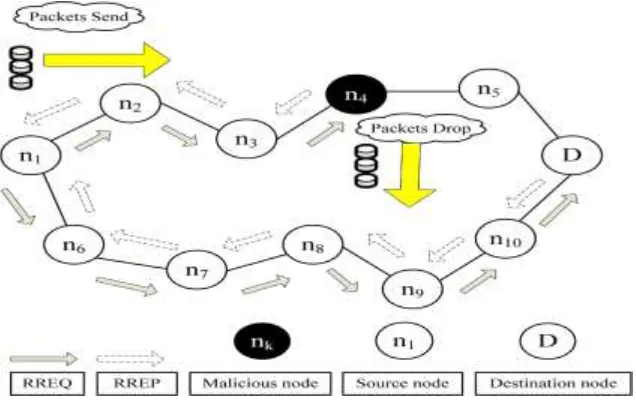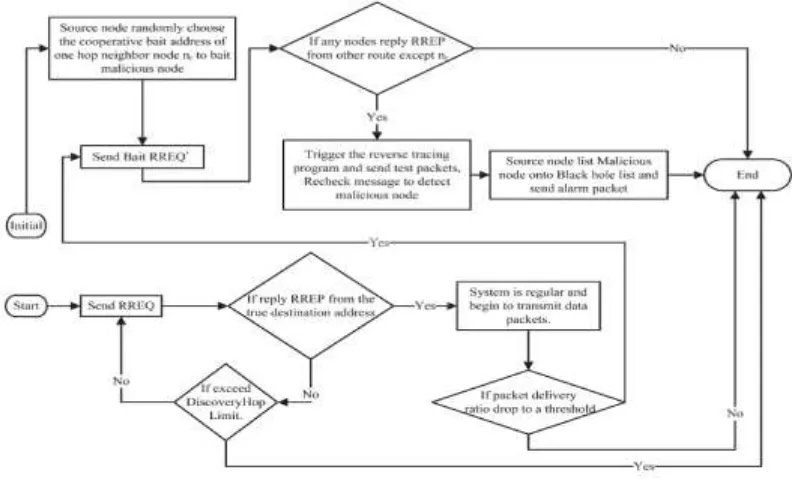Available Online at www.ijpret.com 1578
INTERNATIONAL JOURNAL OF PURE AND
APPLIED RESEARCH IN ENGINEERING AND
TECHNOLOGY
A PATH FOR HORIZING YOUR INNOVATIVE WORK
A REVIEW ON SECURE ROUTING PROTOCOL IN MANET
RAVNEET KAUR T. BAGGA, DR. H.R DESHMUKH,
Dept. Of ComputerScience & Engg., Dr. Rajendra Gode Institute of Technology & Research, Amravati. Accepted Date: 15/03/2016; Published Date: 01/05/2016
\
0
Abstract: Many research works have focused on the security of MANETs. Most of them deal
with prevention and detection approaches to combat individual misbehaving nodes. In this regard, the effectiveness of these approaches becomes weak when multiple malicious nodes collude together to initiate a collaborative attack, which may result to more devastating damages to the network. In this context, preventing or detecting malicious nodes launching grayhole or collaborative blackhole attacks is a challenge. This project attempts to resolve this issue by designing a dynamic source routing (DSR)-based routing mechanism, which is referred to as the cooperative bait detection scheme (CBDS), that integrates the advantages of both proactive and reactive defense architectures. Our CBDS method implements a reverse tracing technique to help in achieving the stated goal. Simulation results are provided, showing that in the presence of malicious-node attacks, the CBDS outperforms the DSR, 2ACK, and best-effort fault-tolerant routing (BFTR) protocols (chosen as benchmarks) in terms of packet delivery ratio and routing overhead (chosen as performance metrics).
Keywords: Mobile ad hoc network (MANET), Cooperative bait detection scheme (CBDS),
Dynamic source Routing (DSR), Collaborative blackhole attacks, Detection mechanism.
Corresponding Author: MR. RAVNEET KAUR T. BAGGA Access Online On:
www.ijpret.com
How to Cite This Article:
Ravneet Kaur T. Bagga, IJPRET, 2016; Volume 4(9): 1578-1584
Available Online at www.ijpret.com 1579 INTRODUCTION
DUE to the widespread availability of mobile devices, mobile ad hoc networks (MANETs) [1], [2] have been widely used for various important applications such as military crisis operations and emergency preparedness and response operations. This is primarily due to their infrastructureless property. In a MANET, each node not only works as a host but can also act as a router. While receiving data, nodes also need cooperation with each other to forward the data packets, thereby forming a wireless local area network [3]. These great features also come with serious drawbacks from a security point of view. Indeed, the aforementioned applications impose some stringent constraints on the security of the network topology, routing, and data traffic. For instance, the presence and collaboration of malicious nodes in the network may disrupt the routing process, leading to a malfunctioning of the network operations. Many research works have focused on the security of MANETs. Most of them deal with prevention and detection approaches to combat individual misbehaving nodes. In this regard, the effectiveness of these approaches becomes weak when multiple malicious nodes collude together to initiate a collaborative attack, which may result to more devastating damages to the network.
Available Online at www.ijpret.com 1580 Fig 1. Blackhole attack–node n4 drops all the data packets.
Available Online at www.ijpret.com 1581 LITERATURE REVIEW AND RELATED WORK
Many research works have investigated the problem of malicious node detection in MANETs. Most of these solutions deal with the detection of a single malicious node or require enormous resource in terms of time and cost for detecting cooperative blackhole attacks. In addition, some of these methods require specific environments [5] or assumptions in order to operate. In general, detection mechanisms that have been proposed so far can be grouped into two broad categories.
1) Proactive detection schemes [6]–[12] are schemes that need to constantly detect or monitor nearby nodes. In these schemes, regardless of the existence of malicious nodes, the overhead of detection is constantly created, and the resource used for detection is constantly wasted. However, one of the advantages of these types of schemes is that it can help in preventing or avoiding an attack in its initial stage.
2) Reactive detection schemes [13]–[15] are those that trigger only when the destination node detects a significant drop in the packet delivery ratio.
Available Online at www.ijpret.com 1582 PROBLEM ANALYSIS
The lack of any infrastructure added with the dynamic topology feature of MANETs make these networks highly vulnerable to routing attacks such as blackhole and grayhole (known as variants of blackhole attacks). In this project , a mechanism so-called cooperative bait detection scheme (CBDS)] is presented that effectively detects the malicious nodes that attempt to launch grayhole/collaborative blackhole attacks. In our scheme, the address of an adjacent node is used as bait destination address to bait malicious nodes to send a reply RREP message, and malicious nodes are detected using a reverse tracing technique. Any detected malicious node is kept in a blackhole list so that all other nodes that participate to the routing of the message are alerted to stop communicating with any node in that list. Unlike previous works, the merit of CBDS lies in the fact that it integrates the proactive and reactive defense architectures to achieve the aforementioned goal.
PROPOSED WORK & OBJECTIVE
This paper proposes a detection scheme called the cooperative bait detection scheme (CBDS), which aims at detecting and preventing malicious nodes launching grayhole/collaborative blackhole attacks in MANETs. In our approach, the source node stochastically selects an adjacent node with which to cooperate, in the sense that the address of this node is used as bait destination address to bait malicious nodes to send a reply RREP message. Malicious nodes are thereby detected and prevented from participating in the routing operation, using a reverse tracing technique. In this setting, it is assumed that when a significant drop occurs in the packet delivery ratio, an alarm is sent by the destination node back to the source node to trigger the detection mechanism again. Our CBDS scheme merges the advantage of proactive detection in the initial step and the superiority of reactive response at the subsequent steps in order to reduce the resource wastage.
Available Online at www.ijpret.com 1583 Figure 2: Operation of CBDS
APPLICATION
1. Have been widely used for various important applications such as military
2. Crisis operations
3. Emergency preparedness and response
A BENEFIT TO END USER
In mobile ad hoc networks (MANETs), a primary requirement for the establishment of communication among nodes is that nodes should cooperate with each other. In the presence of malevolent nodes, this requirement may lead to serious security concerns; for instance, such nodes may disrupt the routing process. In this context, preventing or detecting malicious nodes launching grayhole or collaborative blackhole attacks is a challenge.
CONCLUSION
Available Online at www.ijpret.com 1584
that the CBDS outperforms the DSR, 2ACK, and BFTR schemes, chosen as benchmark schemes, in terms of routing overhead and packet delivery ratio. As future work, we intend to
1) Investigate the feasibility of adjusting our CBDS approach to address other types of collaborative attacks on MANETs and
2) To investigate the integration of the CBDS with other well-known message security schemes in order to construct a comprehensive secure routing framework to protect MANETs against miscreants.
REFERENCE
1. P.-C. Tsou, J.-M. Chang, H.-C. Chao, and J.-L. Chen, “CBDS: A cooperativevbait detection
scheme to prevent malicious node forMANET based onvhybrid defensevarchitecture,” in Proc.
2nd Intl. Conf. Wireless Commun., VITAE, Chenai, India, Feb. 28–Mar., 03, 2011, pp. 1–5.
2. S. Corson and J. Macker, RFC 2501, Mobile Ad hoc Networking (MANET): Routing Protocol
Performance Issues and Evaluation Considerations,vJan. 1999. (Last retrieved March 18, 2013). [Online]. Available: http://www.elook.org/computing/rfc/rfc2501.html
3. C. Chang, Y.Wang, and H. Chao, “An efficientMesh-based core multicast routing protocol
onMANETs,” J. Internet Technol., vol. 8, no. 2, pp. 229–239, Apr. 2007.
4. D. Johnson and D. Maltz, “Dynamic source routing in ad hoc wireless networks,” Mobile
Comput., pp. 153–181, 1996.
5. I. Rubin, A. Behzad, R. Zhang, H. Luo, and E. Caballero, “TBONE: A mobile-backbone protocol
for ad hoc wireless networks,” in Proc. IEEE Aerosp. Conf., 2002, vol. 6, pp. 2727–2740.
6. A. Baadache and A. Belmehdi, “Avoiding blackhole and cooperative blackhole attacks in
wireless ad hoc networks,” Intl. J. Comput. Sci. Inf. Security, vol. 7, no. 1, 2010.
7. S. Marti, T. J. Giuli, K. Lai, and M. Baker, “Mitigating routing misbehaviour in mobile ad hoc
networks,” in Proc. 6th Annu. Intl. Conf. MobiCom, 2000, pp. 255–265.
8. K. Vishnu and A. J Paul, “Detection and removal of cooperative black/gray hole attack in mobile
ad hoc networks,” Int. J. Comput. Appl., vol. 1, no. 22, pp. 28–32, 2010.
9. K. Liu, D. Pramod, K. Varshney, and K. Balakrishnan, “An Acknowledgement based approach
for the detection of routing misbehavior in MANETs,” IEEE Trans. Mobile Comput., vol. 6, no. 5, pp. 536–550, May 2007.
10. H. Deng, W. Li, and D. Agrawal, “Routing security in wireless ad hoc network,” IEEE

